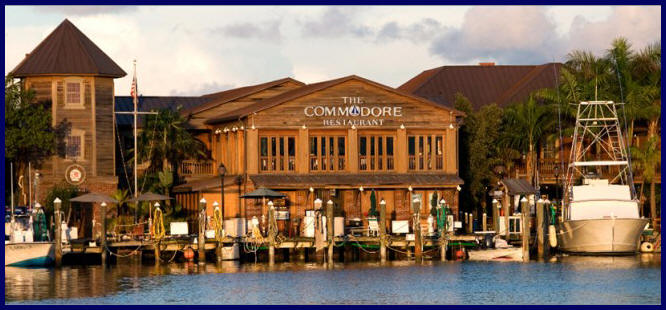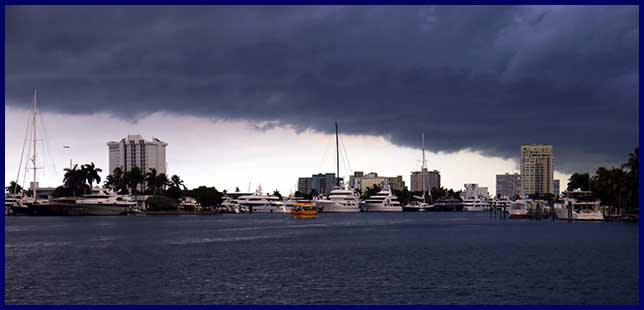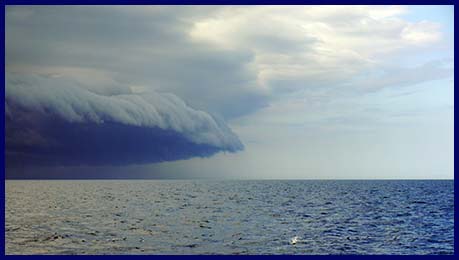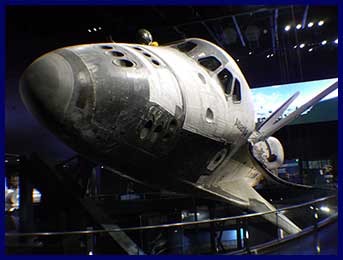
| If you are in Key West as a visitor you're almost certainly doing something sea related - sailing, fishing, diving, or maybe just eating lots of seafood. If you're a local you're probably servicing the tourist in one of those areas. The Keys revolve around the sea and Key West most of all. It's a pretty special place. Sure it's touristy, but in a relaxed board-walky sort of way. Sure, some of the menus in the enormous number of waterfront restaurants seem a bit samey and touristy, but that is because they're all serving the fish that's been caught locally and yes they are serving tourists (like us), but they're also surprisingly good. And the happy hour prices increase the appeal - 1/2 price food and drinks up to 6.30 (and Yes sir, of course you can come in and order as much as you like at 6.29, but you might want to make it a few minutes earlier because a lot of people do, do that). There are also a lot of smaller, less formulaic restaurants once you get away from the waterfront. It's a great place. | |
 |
Then there's Publix! But let me roll back
slightly. We're moored in the marina next to a Floridian motor cruiser .
Cindy's on board full time, but her husband has to go back to the city a few days every
week for work. In a very American way, that we experience time and
again, she's instantly friendly and helpful, "If you need to go shopping, let me know." she says "You
can borrow my car." Hmmm, that's very kind, but of course we don't have
motor insurance. That seems kind of a shameful thing to admit- every US
adult who isn't sleeping in a cardboard box under a railway bridge has motor
insurance, so instead we opt for "Well, we don't know where anything is so why
don't we just tag along next time you go?" Well, neither do I." She says.
"We just got here too!" But thankfully, she agrees and we don't have to
get into our non car-owning status. Cindy takes us first to CVS - that's a pharmacy (or chemist for those of you reading in English). Like an out-of-town super Boots. Not only do they sell everything you can think of vaguely health related. They also sell beer, wine and cigarettes to help you get ill first! What awesome marketing! And then Publix! Publix is the south east US equivalent of Waitrose. They cater for the upper end of the market, have a more interesting range and just like Waitrose all the "workers" own a bit of the company. The workers also (in a very un-Waitrosey sort of way) keep talking to you. "How y'all doing today?" "Have you found everything you need?" It's not just once or twice, it's all the time. I took to keeping an eye out for them and ducking down aisles to avoid them - though I confess, now I don't even notice it. That to one side we like Publix. Our problem when we first arrived was buying so much stuff. We'd spent so long in countries where if you saw something even vaguely appealing, you bought loads of it, we took some weeks to adjust to the fact that Publix would almost certainly have that coffee, wine, cheese, etc tomorrow, the next day and the next day. So we really didn't need to fill the boat with them. |
| All boats in US
waters that have toilets on board are required to have holding tanks.
It's illegal to pump waste into the water less than 3 miles from land
and most marinas have pump out facilities. We've heard stories of
boats being boarded and fined thousands of dollars just for not having
their discharge valves secured in the correct position. We (I) are
a little paranoid about this. We have a holding tank. It's a
very expensive custom built one that we installed 12 years ago before we
left the UK, but in all that time and 25,000 miles we have never, ever
before been in a marina that has pump out facilities! So we have
no idea whether the system will actually work. Best find out
before we're boarded by the Poo Police thinks I! Off to the marina
to collect the seeming miles of hose required to connect into their
suction system. First problem is that we have no way of connecting
the hose to our deck fitting. So off to West Marine to buy
appropriate widget. Then connect everything together, open valve
on the dock and............. Nothing! I speak to the young guy on a neighbouring motor boat to ask if he's ever used the system - "Of course." He doesn't actually say "hasn't everybody", but it's implied. He walks over to Samarang. "You've got the hose reversed. You're going to end up with a very messy deck!" He's talking to me now like a very stupid child. Probably appropriate as what he says is now blindingly obvious. Whilst I'm reversing the hose he asks "And did you actually switch the system on?" He rolls his eyes. I hadn't realised. Quarter of a mile back down the dock, behind a bush, is a big tank and a master switch. After that, whoosh - Job done! The young guy has disappeared back to his boat and is probably already texting his mates about the stupid old English guy. Key West is a natural crossroads and was to be a parting of the ways for a small group of boats who had gelled together waiting for, and during, the trip up from Mexico. Although we actually knew some of them quite well, there were others for whom our farewell dinner would be the first time they became more than crackly voices on the radio.
And we're off too! Up through the Keys on the ocean side (inside the reefs being too too shallow for us), generally not enough wind to sail, not too many places to stop or at least not with enough depth for us. The log reads repetitively - Sails up, engine off - No wind - Engine back on - Thunderstorms - Anchored for the night and off at first light. At least the Gulf Stream is on our side. This far south we only have to go a few miles offshore and we're on a magic carpet lifting us North - and that is where we're heading. So we skipped Miami, though we do anchor in the middle of nowhere, in the Atlantic Ocean, one night where we can actually see the lights on the skyscrapers in Miami Bay, but the first "proper place" we'll reach and enter after Key West is Fort Lauderdale. |
|
| Fort Lauderdale is a Class A inlet ie big
ships/any weather, so no problems there. Getting from the entrance to the
moorings will be our first encounter with the Intracoastal Waterway (ICW) and
its bridges. Only about 2 miles of its 3,000 mile length and only one
bridge, but one small step...... The ICW runs just inside the coast from
Norfolk, Virginia to the Florida keys with a spur running along the gulf coast to Texas. An amazing thing, a
navigable waterway, with a design controlling depth of 10ft along it's entire
length and all bridges a minimum height of 65ft or opening (both at Mean Low
Water). Samarang draws 7ft and her height to the top of her lightning
conductor is 64ft - so not a problem. Except - Ah there's the rub!
Not all the bridges were quite built to spec (the most notorious being the Julia
Tuttle bridge in Miami at 56ft). Julia Tuttle, the mother of Miami, owned
most of the land Miami was built on. Don't know much more about her than
that, but I'm assuming she had a fear of high places or higher than 56ft at
least. Also, not all the channel was ever quite
dredged to 10ft and there's no longer the budget for the necessary dredging so
many areas have silted up - south of Miami the controlling depth is now 5 ft.
Our 2 miles and 1 bridge should be a walk in the park, but even those bridges
which have been built to spec,
look pretty low as you approach them! But of course it was OK and we spent
the next week or so swinging on a mooring buoy outside Las Olas Marina with a
full foot of water under our keel. Certainly much more comfortable there
than out at sea when those afternoon thunderstorms start rolling in! What to say about Fort Lauderdale, if you've never been. Well I think a cross between Venice and Milton Keynes, with a bit of Blackpool sea front thrown in. It's attractive, modern and clean, it's built on a grid system and like many US cities seems to lack any identifiable centre. Instead there are ubiquitous malls, which I suppose act as distributed centres. Not quite the same as a high street though. |
 |
| It also has an
extensive network of canals (that's the Venice connection) though
they too are built pretty much on a grid system. The overall
result is actually really pleasant and Fort Lauderdale also has
something which we will discover is almost unique in the south - a
public transport system. And one that actually works! The Blackpool connection? Almost forgot, Lauderdale has a very long white sandy beach fronting the Atlantic, which is a magnet for tourists and of course to service those tourists are the predictable tacky restaurants, bars and souvenir shops (sorry Blackpool). Though to be fair when we use the word tacky you have to understand we have yet to visit Daytona! Fort Lauderdale also has a very active marine police force. We watched our neighbours pulled over and fined for travelling the 200 yards from their boat to the marina dock without their life jackets and Lindy was later reprimanded for breaching the city ordinance which forbids hanging washing outside. Fortunately it was dry as it had to come inside. |
|
 |
We left Fort Lauderdale and
headed north. Every afternoon brought powerful thunderstorms at
this time of year in Florida, so our plan was to leave early and make
short hops up the coast, getting in early before the weather
deteriorated and the lift from the Gulf Stream certainly helped with
this. So next stop Lake Worth (AKA Palm Beach). I know it
sounds romantic, but for us it was a muddy tidal anchorage in the rain
with a great view of a ship yard and no obvious way of getting ashore.
Off to Fort Pierce. That doesn't sound anywhere as romantic and it
isn't. There are such strong currents and such limited anchoring
that we're forced into a v.expensive marina miles from anywhere.
Next - Cape Canaveral, at least that has some cachet! Nowhere to
anchor there, just a deep channel for cruise ships, space ships, etc.
So another marina. But, not only was it a nice marina, Clayton the manager was really helpful. We wanted to visit the space centre. Can't go to Canaveral and not see the space centre! "Well you really shouldn't go from here. You should go from Titusville, it's much closer." "Hmmm, that's up the ICW, we draw 7ft, have 64 ft mast, etc." I've rattled this explanation off a few times by now and have it off pat. "Not a problem" says Clayton "I live in Titusville and keep my own boat there. I wouldn't be surprised if you could get all the way to Georgia on the inside if you wanted to." I'm trying to be polite here, but clearly I look a bit sceptical. "Why don't you ring BoatUS and ask them. They know where all the shallow places are." suggests Clayton. (BoatUS & Seatow are the US nautical equivalent of the UK's RAC and the AA. We'd joined almost the first day we arrived and Clayton knows I'm a member as I get 10% discount on the marina fees.) It's a brilliant idea! Writing this in retrospect I can tell you that I have now spoken, sometimes more than once, to every single BoatUS captain between Vero Beach and Brunswick. And Clayton was absolutely right of course. |
| So, first we request that the bridge is
opened, then request a transit through the lock, then wait for a timed opening
of the canal bridge, and into the ICW
and off to Titusville. It has to be said that Titusville is pretty
shallow. Controlling depth in the marina is 7ft, we draw 7
ft...........Hmmmm. There's not even any tide here to help - remember the
lock, that's why it's there! Not to worry there's a big mooring field where we can
swing with a whole foot under our keel which is also much cheaper than being in
the Marina.
Titusville has a (very infrequent) bus service plus a supermarket and a couple of restaurants in walking distance. So quite a lot going for it from a cruising perspective. But the main reason we're there is to visit the Kennedy Space Centre. We also see cruising friends Phil & Nikki on Ajaya who we met 2 years before in the San Blas Islands. The Space Centre's glory days are well behind it - though it's still really worth the trip and it is incredibly well organised. The space race is over and the budgets have shrunk. With the retirement of the Space Shuttles the US doesn't even have a way of getting its astronauts to the International Space Centre any more. It has to pay Russia to give them a lift, which must be just a tad embarrassing! Funding is increasing again with the Orion project, but this time with a lot more investment from the private sector - the aerospace and technology giants. I guess they will keep a somewhat firmer control of expenditure, which to some extent may be a good thing. One can't help but feel that much of what we saw was built because it could be - whatever the cost. Another thing that impressed me, was how crude much of the technology now seems. Most of us have more computing power in our phones than NASA had available to send those guys to the moon and back! |
 |
 |
On up the ICW. We're required to
report in to Customs each time we move, but even they haven't heard of some of
the places we stop. New Smyrna - "Where? Well tell me somewhere its near
then." "Actually, it's not near anywhere" I tell him. He sighs "OK,
spell it for me then". Then Daytona Beach - Super tacky. Palm Coast -
great marina, lovely people, but again - not really anywhere, though we did get
a lift to Publix. And then St
Augustine. The oldest (continually occupied) European settlement in The
USA. A lot of things in the US claim to be oldest, biggest, etc followed
by a list of sometimes pretty obscure qualifications. Being old is
particularly important it seems. And St Augustine is pretty old (450 yrs) by US
standards - though the oldest bits were actually built by the Spanish. And it
is also one of the best places to be for the 4th of July celebrations and we
have arrived on the 3rd to take up our spot for the fireworks. St Augustine marina runs a number of large mooring fields. They also run a water taxi and pump-out boat all included in the $25/night fee, which makes them the best run moorings we've encountered in the US. The town is actually really nice. It is touristy, of course, but in a much more civilised and sophisticated way than many other places and you don't have to walk too far to find good restaurants. Our favourite was The Old City Inn and worth the trip just for it's lunch - probably the best food we'd yet eaten in the US and at bargain basement prices! We would be back to St Augustine and to The Old City Inn on our way south in the winter, though without the fireworks. The next section of the ICW looks pretty wiggly so as we'll pass the St Augustine exit anyway we decide to head out to sea. There's not enough wind to sail, but the opportunity to put on the autohelm and stop having to hand steer is too good to miss. Back in again at the St Johns River entrance. Another big ship entrance and a big river. Navigable for 40 miles for us to Jacksonville and beyond. Actually navigable for much, much further, but it's those bloody bridges again. The only downside of a river of this size is the current making anchoring a tad tricky. |
| Tonight though we weren't anchoring we were stopping at Morning
Star Marina. Did this make the current problem go away? Absolutely
not! Mooring and slipping with 4 knots of current running through the
docks is much worse than anchoring. We are here because MetroPCS, our
cellular supplier (even after a couple of hours of mind numbing discussion) is
totally incapable of taking a UK credit card to top up our phone balance and
is about to
cut us off, not just from voice but from internet - if we can't get to a Walmart
and buy a top-up card! Morning Star Marina has a courtesy car we can
borrow and a map, thanks. Off the dock the following morning with 4 knots of current behind us. Horrible, truly horrible. Back out to sea for the day and in again at the Fernandina entrance. Also pretty horrible. Lots of current, lots of swell. Not to be considered with any sort of sea running. Fernandina bills itself as a kind of mini St Augustine - we were looking forward to it, but the reality is Fernandina stinks. By that I don't mean that it's not much of a place, I mean it smells. The town is sandwiched between two factories (paper/plywood) and no matter which way the wind blows the whole place is suffused in a vomit inducing stench. Fernandina has a mooring field just like St Augustine - same buoys, same price, but no water taxi, no pump out and, instead of nice hull friendly nylon thimbles on the pickup lines Fernandina has instead chosen sharp paint-scratching metal ones. The marina staff are non too friendly and the dinghy dock is a very long way from the office. Ashore, Fernandina boils down to a well maintained high street with various restaurants, clothes and trinket shops. There is though, one really nice restaurant - it's down a side street and when we found it, it was full and they couldn't seat us. There being little choice we went back the following day and Barry had his first ever Shrimp 'n Grits. The Restaurant was worth the visit. The grits? Hmmmm. After Fernandina, we spent one night in a muddy, narrow tidal estuary at Jekyll Island, then up at dawn to get under a bridge and then negotiate the narrowest, windiest, shallowest stretch of the ICW so far, and out we popped into the Brunswick River. Under the super high 56 meter fixed bridge and up the channel to Brunswick Landing Marina, which would be home/basecamp for the next several months. |
|